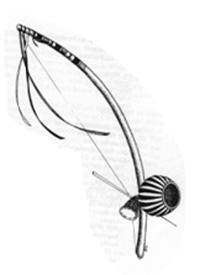
The central ritual of contemporary capoeira is the roda de capoeira
or "ring" of capoeira. The bodies of the other players who sing and direct
the game with music form the circle within which the players will test each
other. As much a game against one's self and one's limits as against a
person's "companion" in the roda, capoeira demands that a person
try to assert control over the space and the other player more with
precision and mobility than with violence. The way of capoeira is not to
resist, not to meet force with force, but instead to flow around, over,
under, away, searching patiently for the right moment in which to strike.
A good player is not violent. On the contrary, a good player is an artist
who renders another's violent intentions impotent. The great capoeirista does not tire or feel fear, but, driven by the music of the berimbau and the singing of his or her comrades,
continually finds new sources of energy and potential within the spirit.
and the singing of his or her comrades,
continually finds new sources of energy and potential within the spirit.
While the acrobatics are what first attracts the audience to capoeira, watch for the relationships that develop in each game. The well-timed leg sweep, the devious head-butt, the perfectly-executed escape from certain capture, the move that impossibly changes from one thing to another in response to the other player - these are the hallmarks of a good player. A good capoeirista does not simply fight and trade blows; he or she creates in every game.
While scholars and capoeiristas alike debate ferociously whether capoeira is "African" or "Brazilian" or some combination of the two, it is safe to say that capoeira is firmly rooted in the experience of Africans and their descendants in Brazil. Some argue tha capoeira was a weapon in the struggle for liberation, part of the heritage of Africans in Brazil turned against the slaveholders in revolts that rocked Brazil and in the defense of the Quilombos, communities or nations of escaped slaves organized by African leaders in the Brazilian backlands. Following slavery, gangs of "capoeiras" (the word originally referred to the person who did the action and not the practice) terrorized cities in the south and acted as shock-troops in the war against Paraguay and in the struggle between republican and monarchist forces in the 19th century.
Whatever the origin, the contemporary form of capoeira as we now practice it owes its continued existence to the rodas of Salvador, Bahia, and the nearby towns surrounding the Bay of All Saints. While in Bahia capoeira also served as a weapon for the men who lived in the margins of the city - the razor blade associated with the gangs in the south also serving in the hands of Bahian "capoeiras" - the form of the roda took its definitive form there. Sunday after church and on the days of religious festivals, the men who played capoeira, still dressed in white out of respect for the orixás (African deities) and saints, would form rodas in the the streets or in the shade of a tall tree and play for hours. It is in these rodas that capoeira was passed from teacher to student by watching, listening, trying, and falling.
Mestre Bimba would change this when he opened the first academy for the teaching of capoeira in Salvador. He attracted university students, the sons of the middle class, and dedicated crusaders for the art to his academy. There Capoeira Regional was born (in opposition, sometimes, to the traditional form which came to be called "Capoeira Angola"). Mestre Bimba provided Capoeira Regional with a system for teaching and training and the enormous stature and charisma that he possessed. A distrustful man and invulnerable fighter, Mestre Bimba would never be fully-appreciated by the Bahian government even though the Brazilian dictator Getúlio Vargas became so impressed watching a presentation by Bimba and his students that he declared capoeira the "only truly national sport of Brazil." In spite of the fact that Mestre Bimba would die hungry in the state of Goias, his capoeira would be spread by his students and others around the world.
Today capoeira is practiced around the globe; from the United States, Canada, England, Germany, Italy, and France to such places as Argentina, Israel, Mozambique, and Japan. It first came to the United States, specifically to New York, two decades ago and has slowly spread throughout the country to a host of cities including San Francisco, Seattle, Denver, San Diego, Milwaukee, Washington, Orlando, Boston, and many others. Three years ago, after several false starts, capoeira came to Texas.
Also available from the University of Chicago Press is J. Lowell Lewis' Ring of Liberation: Deceptive Discourse in Brazilian Capoeira (1992). Lewis' book is based on his field research as an anthropologist principally in Salvador, Bahia, Brazil, the city considered to be the cradle of modern capoeira as it is now practiced.